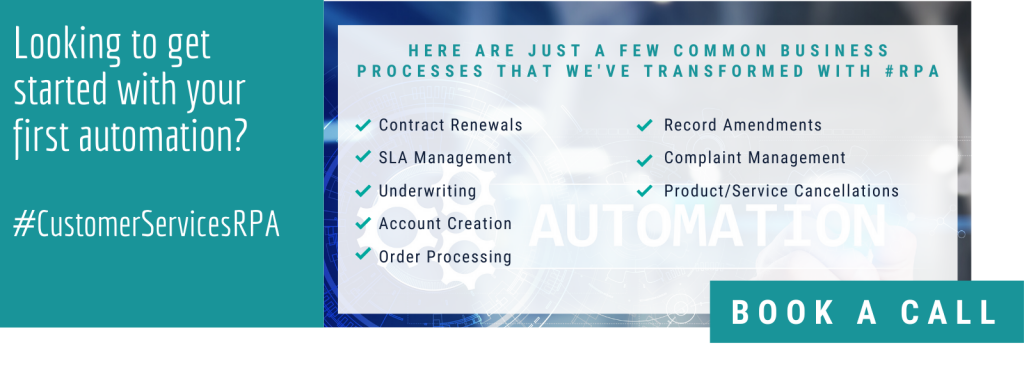Now that you’re fully up-to-speed with low-code (if you want a recap, you can read our low-code FAQ here) it nicely leads us into the most frequently asked questions that we get to answer whenever we talk to business owners and leaders about how they can improve business productivity and free-up their staff’s valuable time from mundane, every day processes.
What is RPA?
RPA is really as simple and powerful as it sounds. Robotic Process Automation enables you to create your own software robots (or Digital Workers) to automate any business process. Your ‘bots’ are configurable software set up to perform the tasks you assign and control.
The secret ingredients are time, flexibility and intelligence. Compared to other ways to automate, Robotic Process Automation takes a fraction of the time while being able to execute in any environment and across any application. RPA ‘bots’ can start immediately, scale on demand, and keep working at 100% capacity non-stop 24/7 x 365. Add cognitive automation (AI and ML), and your digital workforce can handle even complex unstructured information to automate any business process from end to end.
What is a robot or ‘bot’?
A robot for automation of back office processes is software that moves between different IT systems, just like a human; it mirrors the actions of a human operative. But a robot is a digital staff member that, having user names and passwords to the IT systems, logs in there and performs the same operations that a human would.
Why do I need a Robot?
A robot performs repeatable and mundane tasks which releases the time of the employee who can carry out more creative operations, such as contacting clients, learning and interpreting regulations, giving opinions, making decisions, etc. These are operations that cannot be carried out by a robot, since they are creative and cannot be described by an IT algorithm. A robot establishes invoices or reminders, meanwhile the employee focusing on more important tasks creates the real value for the company.
What are the advantages of RPA?
A robot decreases the costs of handling of monotonous and repeatable processes, handling that is often time consuming for a human operative. While handling several accounting systems or other applications on websites, it performs the same operations as a human: it logs in, downloads files, opens them, checks up the data and enters the information to the document. The robot’s work cost may be two times, and sometimes even 10 times lower than the employee’s work cost.
Where can RPA be used?
There is no real limit to where RPA can be used within a business. However, typically RPA is used for high volume data driven transactional tasks such as finance processes (invoice processing, Accounts payable, credit control etc.) or the amalgamation of data sources.
Is RPA expensive?
There is a wide spectrum of RPA vendors and the price range varies according to the functionality as well as the complexity of the software. Solutions can cost a few thousand for simple solutions through to enterprise level budgets for global corporations.
Is it difficult to implement and maintain RPA?
There has been a lot of hype about RPA implementations. They can be deployed in sensible tranches or they can be large projects with teams of people working on a delivery. Like every good business project, it is about managing risk, benefits and keeping focus on what will deliver a realistic and valuable ROI.
At Velocity, we general start small with an initial Proof of Concept (PoC). This can be an effective way to make sure there is alignment between what is possible and what is practical. Once value and benefit has been established, we work with our clients to build out more systems and automations across the business in manageable tranches (i.e. little and often) to maximise value.
How do robots deal with human judgment?
Robots for now only follow rules. Where a procedure requires interpretation and skill in judging an outcome then a robot may not be suitable. One technique that is common is to re-organize task-steps so that any judgment is dealt with up front – the work is prepared for robotic automation. In this way robots can handle bulk rules and hand off to humans once judgment is needed.
What does RPA cost?
Building a business case for RPA bots that can be in place in a matter of weeks, at a fraction of the cost of a human workforce is pretty simple with our RPA Cost Estimator Tool – get an Instant Cost Estimation here.
What technology does Velocity specialise in?
Platforms we specialise in include (but are not limited to); UiPath, K2, Mendix, Netcall, Office 365, Dynamics 365 and Microsoft Azure technologies) – using our skills and experience with this software toolkit we help companies achieve bottom line efficiency, productivity and profitability improvements.
Who has Velocity built process automation solutions for?
Our clients include organisations such as CBRE, Zurich Insurance, the Ministry of Defence, Motability, Wales and West, Network Rail, Rolls Royce, MOD and many more.










